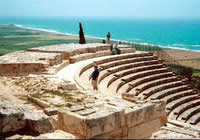|
|
| |
| |
| |
|
| |
 |
| |
|
| uses Google technology and indexes
only and selectively internet - libraries
having books with free public access |
|
 |
|
|
 |
|
| |
|
| |
Previous | |
Next |
|
 |
CLAUDE DELAVAL COBHAM
Exerpta Cypria
page 393 View PDF version of this page possessed this island of Cyprus, baring derived it from his ancestors. To this monarch Agamemnon, according to Homer, was indebted for his breastplate. The cities of Urania and Idalinm were also founded by the same people: the former received its name from Urania Venus, whoee worship, as related by Herodotus, was transferred to Cyprus by the Phoenicians from Ascalou. Citium derived its name from the Hebrew appellation for the island, dietim ; the Chitim, or Citthn, of the Holy Scriptures. It was fanions as the birth-place of Apollonius, a disciple of Hippocrates ; and of Zeno, who, being shipwrecked upon the coast of Attica, from a Phoenician merchant became founder of the Stoics, and had for his illustrious followers, Epictetus and Seneca. According to Plutarch, it was with the sword presented by a King of Citium that Alexander triumphed over Darius. This weapon was held by him in snch estimation, that he always wore it upon his person. The same author also informs ns that at the Biege of Citium, Cimon, son of'Miltiades, received the wound whereof he died.
It is quite uncertain when this city was destraj-ed. Mariti believes that event did not take place later than the beginning of the third century. In 1767, an excavation being made to procure from its ruins materials for building, the workmen discovered a marble bust of Cara calla, some medals of Septimius Severus, Antoninus Caracalla, and Julia Domna, with Greek inscriptions. Upon their obverse sides were exhibited the Temple of Paphos, with the legend KOINON ΚΥΠΡΙΩΝ. Some of them had the image of Caracalla on one side, and that of Geta on the other. There were also others with the head of the Emperor Claudius.
Many circumstances occurred to excite onr curiosity concerning the interior of the island ; although we despaired of being able to penetrate as far as Baffa, the antient Paphos, on account of the plague, then raging over all the western part of Cyprus, and particularly at Baffa. The ruins, and other antiquities of this place, are numerous.
Sir Sidney Smith removed some inscriptions already alluded to ; and the English Consul at Larneca presented me the hand of a colossal marble statue, found there, of the most exquisite sculpture. We also hoped to enrich our collection of plants, and make some observations concerning the minerals of Baffa, especially a beautiful variety of crystallized quartz, as diaphanous as the rock-crystal of the north of Norway, called Yeny Maden or Madem by the Turks, and sold by Armenian merchants in the Crimea for diamonds. Before we left that peninsula, Professor Pallas had particularly requested information with regard to the locality of this stone. Among the substances offered for sale as false diamonds, there is nothing more common all over the Mediterranean than highly-transparent quartz; hence the various names of "Gibraltar diamonds" "Vesuvian diamonds," "Baffa diamonds," and many other. We have also, in our own country, the "Bristol diamonds." All natural resemblances of the diamond have, however, been lately eclipsed by a very different mineral, the white Topaz of New Holland. This stone, when cut and polished, with the exception only of the white Corundum, possesses a degree of lustre and liinpidness superior to every other excepting thè real diamond.
The antient mines of Cyprus, now entirely neglected, appear to have been situated towards the Paphian extremity of the island ; for if the natives exhibit any mineral substance remarkable for its beauty, utility, or hardness, they name it, by way of eminence, " a Baffa atone" Amianthus of a very superior quality is found near Baffa, as flexible as silk, and perfectly white ; finer, and more delicately fibrous than that of Sicily, Corsica, or Norway. The Cypriots call this mineral " the Cotton stone."
Early on the morning of June the eighth, having procured an order for mules and asses, and a firman to authorize the expedition, we left the Ceres, and set out for Nicotia, the
CLAUKE.
View PDF version of this page
|
 |
| |
Previous |
First |
Next |
|
|
|